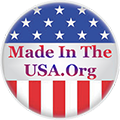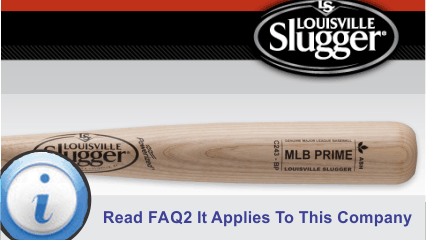One of the products Louisville Slugger sells is Made in the USA Baseball Bats. A more complete list of their products is provided by Made in America Secrets, to review their list click here.
For more information about Louisville Slugger and its American Made products see the following:
In many ways, the rich, 120-year history of the Louisville Slugger baseball bat began in the talented hands of 17-year-old John A. Bud Hillerich.
Bud's father, J. F. Hillerich, owned a growing woodworking shop in Louisville, Kentucky, in the 1880s when Bud began working for him.
Legend has it that Bud, who played baseball himself, slipped away from work one afternoon in 1884 to watch Louisville's major league team, the Louisville Eclipse. The team's star, Pete Browning, mired in a hitting slump, broke his bat.
Bud invited Browning over to his father's shop to make him a new one. With Browning at his side giving advice, Bud hand-crafted a new bat from a long slab of wood. Browning got three hits with it the next day.
From butter churns to baseball history
Browning told his teammates, which began a surge of professional ball players to the Hillerich shop. Yet J. F. Hillerich had little interest in making bats, he saw the company future in stair railings, porch columns and swinging butter churns. For a brief time in the 1880s, he even turned away ball players.
Bud persisted, he saw the future in bats. His father, pleased with his son's enthusiasm, relented. The rest is baseball history.
In 1894, with Bud Hillerich taking over from his father, the name Louisville Slugger was registered with the U.S. Patent Office. In the early 1900s, the growing company pioneered a sports marketing concept by paying Hall of Fame hitter Honus Wagner to use his name on a bat-a practice continued with Michael Jordan, Tiger Woods and so many other professional athletes in virtually all sports today. By 1923, Louisville Slugger was selling more bats than any other bat maker in the country. Baseball was the nation's most popular sport, and legends like Babe Ruth, Ty Cobb and Lou Gehrig all swung Louisville Sluggers.
120 years and still leading the game
Some 120 years have passed since Bud Hillerich crafted that very first bat for Pete Browning. During that time, Louisville Slugger has sold more than 100,000,000 bats, making it without question the most popular bat brand in baseball history. Louisville Slugger continues to dominate the game in both wood and aluminum bat categories. 60% of all Major League players currently use Louisville Slugger. And in the past decade, seven national college baseball champions hammered their way to the top with Louisville Slugger TPX bats.
In recent years, Louisville Slugger has gone far beyond bats, providing performance technology in the form of fielding and batting gloves, helmets, catchers' gear, equipment bags, training aids and accessories. In addition to its on-field performance products, Louisville Slugger offers personalized, miniature, commemorative and collectible bats.
So what would baseball be like if young Bud Hillerich had followed his father's urging and devoted his efforts to making swinging butter churns? We don't even want to think about it.
For more information about Louisville Slugger and its American Made products see the following:
In many ways, the rich, 120-year history of the Louisville Slugger baseball bat began in the talented hands of 17-year-old John A. Bud Hillerich.
Bud's father, J. F. Hillerich, owned a growing woodworking shop in Louisville, Kentucky, in the 1880s when Bud began working for him.
Legend has it that Bud, who played baseball himself, slipped away from work one afternoon in 1884 to watch Louisville's major league team, the Louisville Eclipse. The team's star, Pete Browning, mired in a hitting slump, broke his bat.
Bud invited Browning over to his father's shop to make him a new one. With Browning at his side giving advice, Bud hand-crafted a new bat from a long slab of wood. Browning got three hits with it the next day.
From butter churns to baseball history
Browning told his teammates, which began a surge of professional ball players to the Hillerich shop. Yet J. F. Hillerich had little interest in making bats, he saw the company future in stair railings, porch columns and swinging butter churns. For a brief time in the 1880s, he even turned away ball players.
Bud persisted, he saw the future in bats. His father, pleased with his son's enthusiasm, relented. The rest is baseball history.
In 1894, with Bud Hillerich taking over from his father, the name Louisville Slugger was registered with the U.S. Patent Office. In the early 1900s, the growing company pioneered a sports marketing concept by paying Hall of Fame hitter Honus Wagner to use his name on a bat-a practice continued with Michael Jordan, Tiger Woods and so many other professional athletes in virtually all sports today. By 1923, Louisville Slugger was selling more bats than any other bat maker in the country. Baseball was the nation's most popular sport, and legends like Babe Ruth, Ty Cobb and Lou Gehrig all swung Louisville Sluggers.
120 years and still leading the game
Some 120 years have passed since Bud Hillerich crafted that very first bat for Pete Browning. During that time, Louisville Slugger has sold more than 100,000,000 bats, making it without question the most popular bat brand in baseball history. Louisville Slugger continues to dominate the game in both wood and aluminum bat categories. 60% of all Major League players currently use Louisville Slugger. And in the past decade, seven national college baseball champions hammered their way to the top with Louisville Slugger TPX bats.
In recent years, Louisville Slugger has gone far beyond bats, providing performance technology in the form of fielding and batting gloves, helmets, catchers' gear, equipment bags, training aids and accessories. In addition to its on-field performance products, Louisville Slugger offers personalized, miniature, commemorative and collectible bats.
So what would baseball be like if young Bud Hillerich had followed his father's urging and devoted his efforts to making swinging butter churns? We don't even want to think about it.

